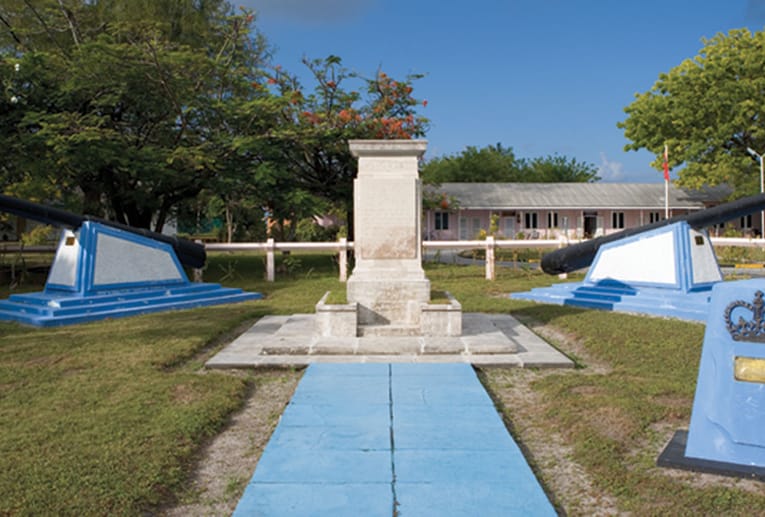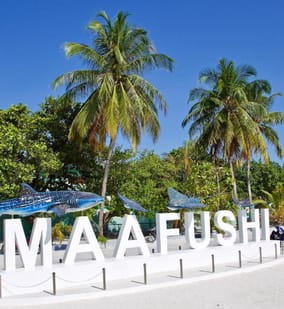Fascinating History of How WWII Brought to the Maldives

Maldives consists of 26 natural atolls. Today, Addu Atoll, the southernmost atoll in the Maldives, is a mix of sleepy villages and untouched islands. But in 1941, it became one of the British Armed Force’s most important strategic outposts.
Many men died on its serene shores, mainly through accidents and illness, and their service is commemorated at the Maldives’ only war memorial on Gan Island.
Anyone who travels beyond the pristine beaches and unbridled luxury of the more northern resorts will find a stone pillar and two large guns on the lawn outside the former Royal Air Force Headquarters at Gan, bearing the names of 70 servicemen who died there during World War II.
History of the British Armed Forces at Gan…
With the outbreak of World War II, the Maldives became an essential link in the allied defences against the Japanese in the Indian Ocean.
The British secretly began building their base, known as ‘Port T’, in 1941. Gan Island was completely cleared of vegetation to make way for a runway, and its villagers were relocated. Operations spread to other parts of Addu, with a base for seaplanes built at Hithadhoo lagoon, where planes flew in from as far away as Singapore and Sri Lanka, and underground bunkers for supplies and bombs constructed at Maradhoo. A series of causeways were also constructed between the main islands, and anti-submarine nets and mines were installed around the atoll.
The enemy was never far away from this tropical outpost, and U-boats patrolled the waters. In March 1944, the German submarine U-183 fired through the Gan channel, torpedoing the oil tanker British Loyalty that was anchored in the Addu lagoon. The tanker was damaged but not sunk, and its oil spilt out into the lagoon and beaches.
The British Loyalty was repaired, and remained in the atoll as a storage hulk for the rest of the war. It was finally scuttled in January 1946 inside the atoll to the southeast of Hithadhoo. The wreck now sits at the bottom of the lagoon and is one of the most spectacular dive sites in the Maldives.
The men who served and died in the Addu Atoll were predominately Indian, members of the Bengal and Indian regiments who were stationed there soon after the base was constructed.
Gan After The War…
When World War II ended, the RAF (British Royal Air Force) wanted to hold onto this strategic position at Addu, building a new airbase at Gan and a radio-communications centre at Hithadhoo in 1957. It was an ideal re-fuelling and supply post on the route linking the UK to Hong Kong, Singapore, Australia and the rest of East Asia.
A lease was granted to the British to occupy the Addu Atoll Gan island for 30 years, an agreement that was upheld after the Maldives gained independence in 1965. In fact, the British withdrew from Addu in 1976, before the lease expired.
RAF Gan was a busy and important base. It covered one of the largest aerial search areas in the world and handled thousands of aircraft and passengers during its operation.
The buildings are well preserved, and today, the RAF airfield at Gan has become an international airport. The base itself has been transformed into one of Addu’s few resorts, the Equator Village, and the old forces hospital now houses a dive centre.
About Addu Atoll…
Addu Atoll is the biggest (in terms of population) and most important (in terms of economics and administration) area of the Maldives after the capital Malé. This bird-shaped atoll is made up of around 20 uninhabited islands and six inhabited islands.
The four main inhabited islands in Addu Atoll – Gan, Feydhoo, Maradhoo, and Hithadhoo, are known collectively as Addu City, one of only three urban areas to get the status of "city" other than Malé (the others being Fuvamulah and Kulhudhuffushi). The bridges and causeways that link them create the longest continuous stretch of land in the Maldives, at 14km.
There are just three resorts this far south, plus a few guesthouses, but the real appeal is the chance to experience a side of the Maldives that’s down to earth and largely unpolished rather than five-star and all-inclusive.
Unlike many of the luxury resort islands, the guests and staff have access to the local villages, meaning staff can go home at the end of the day, and travellers get to see beyond the sheen and glamour to what life is really like in the Maldives.
Addu Tourism…
Tourism in this southernmost atoll has been slowly expanding over the past few years, attracting those who want to journey beyond the slick resorts, experiencing village life and learning about Maldives' history.
The Addu Atoll is one of the fascinating corners of the Maldives and is definitely worth the extra 300-mile trip from Malé.








